ALEXANDER POGREBINSKY FINE ART
Biography p.1
Biography p.2
Biography p.3
The Washington Post
The Plain Dealer
Catholic Bulletin
D2
It is not a coincidence that Alexander Pogrebinsky became the artist he is today. He was born into an artistic family; both his parents were distinguished artists of the Socialist Realist school of painting in the Soviet Union.
The history of Socialist Realist Painting is the tale of an extraordinary movement in the art of our century. It entailed the sponsorship of realistic painting on a scale unmatched anywhere in the world and engaged for decades the talents of thousands of artists across a vast, multiracial empire. It emphasized the social role of art; it insisted on the superiority of content over form; it required a wholesome return to traditional skills and regarded the history of European art from the Renaissance onwards as a living source of inspiration. It was directly and deliberately opposed to the solipsism, formalism and yearning after a tabula rasa of the modern movement; and it provided the only full-blooded and thoroughly conceived alternative to it. (Bown, Socialist Realist Painting, 1998).
Peter Nikolayevich Pogrebinsky (1911 - 2002) and his wife Liubov Romanovna Solona (1914 - 1990) were both skilled artists of Kiev and graduates of the Kiev Institute of Art, now known as the Kiev Academy of Arts. Both were involved in the cultural life of the city.
Pogrebinsky is living and working in the United States. He was born in Kiev. From birth Alexander found himself in a world of brushes, paints, and colors. His interests in drawing and sculpture where clearly visible since childhood. The young Pogrebinsky could spend the whole day sculpting all kinds of figures out of clay.
In 1958 Pogrebinsky entered a special French school, where all subjects where taught in the French language. And in 1963 Pogrebinsky passed all the entrance exams and entered the only high school for the arts in the whole of Ukraine. This kind of school existed only in Kiev, Moscow, and St. Petersburg. Along with the regular curriculum of the school, it also offered intense courses in the fine arts, and prepared the young students for the future as professional artists. The first four years where dedicated to watercolor, drawing, sculpture, and composition. Again, Pogrebinsky proved his amazing talent in sculpting. Thus his teachers advised Pogrebinsky to pursue sculpture as his artistic career. The final three years of his education at the school were dedicated to the study of oil painting, drawing, and composition. Pogrebinsky, as other students, used live models for his studies.
It was around this time in school that Pogrebinsky became interested in the ancient art of Yoga.
Through Yoga he became fascinated by the ancient philosophies and religions of ancient India. And later the study of German philosophy, and world philosophy in general.
He wished to read many books in their original language. This influenced Pogrebinsky to study foreign languages. In 1970 Pogrebinsky entered a three year course in foreign languages. And in 1971, at the age of 20, he received a degree in French. His fluency and degree earned him the right to teach and translate in the Soviet Union.
In 1970 Pogrebinsky passed the competitive entrance examinations for the Art Institute of Kiev. The Institute accepted only 15 new students per Major every year, about 350 applied annually. The Institute consisted of six Majors: Painting, Graphics, Sculpture, Theatre, Art History, and Architecture. He entered the Institute with Painting as his Major.I
In the course of six years Pogrebinsky studied the subjects of Painting, Drawing, Composition, Perspective, Technology of Art Materials, Anatomy, Basics of Architecture, and a whole school of theoretical subjects like philosophy, art history, etc.
Pogrebinsky studied in the studio of Academician Victor Vasilievich Shatalin, Professor, and National Artist of the Soviet Union. Pogrebinsky greatly respected and loved his teacher. The friendship between the two artists exists to this day.
In 1976 Pogrebinsky graduated from the Institute with a diploma of an Artist in the Art of Painting.
After this Pogrebinsky began working as an independent artist, with many commissions and exhibitions.
In 1987 Pogrebinsky painted Komsomol for which he received the First Lenin Prize of the Ukrainian Komsomol (could be the equivalent of Pulitzer Prize, but in artistic achievement). In the same year Pogrebinsky was accepted into the highly distinguished Union of Artists, which was rare for an artist of his age. Also that year Pogrebinsky was accepted into the Academy of Arts of the USSR, the highest educational institution for artists.
In the Academy Pogrebinsky was taught in the studio of Sergei Alexeavich Grigoriev, National Artist of the Soviet Union, and Academician. And also under the supervision of Academician Alexander Gritsai.
During these years Alexander produced paintings which were displayed in national exhibitions, as well as those of the republics of the USSR. As his dissertation Pogrebinsky painted To The Top a painting about alpinists. A painting which took Pogrebinsky to the Republic of Georgia to collect materials for the work.
In 1979 Pogrebinsky met with Lena Zinchenko at the studio of sculptor Sergei Youhno. In 1980 they were married and two children where born, Alexander and Natalie.
Every year Pogrebinsky displayed his work at the exhibitions in Moscow and Kiev, and worked on his private commissions. One of his most famous works of the time was the triptych Let There Be Sunshine was composed in 1984. Pogrebinsky used his wife and children as the models for this work. Throughout the years Pogrebinsky’s family appears to be the main source of modeling for his work.
The central part of the triptych was published in the famous magazine Ukraine, equivalent to America’s Time Magazine. The triptych was purchased by the Ministry of Culture of the Ukraine, and to this day is displayed at different exhibitions in Kiev.
Another famous work of the time was commissioned by the Ministry of Culture, the painting Lenin and the American Journalist Williams. This historical work can be found in the Museum of Kiev.
Out of his personal works, not commissioned by any Soviet officials, was Vroubel which is located in the Museum of Kiev. And the painting masterpiece In the Memory of Mikhail Boulgakov or Boulgakov, which was displayed in France and purchased by a private American collector. This painting was one of the last great works of the artists Soviet Period.
The decision to immigrate was extremely difficult for the family. In 1990 the artist and his family immigrates to the United States of America and begins a new life. Without knowing anybody, with only three suitcases, Pogrebinsky and his family had to start from scratch. A new world with its own customs and culture was yet another challenge in Pogrebinsky’s life. Fortunately his understanding of Western languages proved helpful to the young artist and his family. As the Cleveland Plain Dealer wrote, "In deciding to leave, the Pogrebinsky's said goodbye to family and friends, and killed a familiar way of life."
Thus begins a new period for the artist. With his paints and paintbrushes he brought with him from the USSR he begins to create his first works in America. His first works were mostly landscapes and still-life’s where displayed at a small gallery in Detroit called Chaika. These works sold well and Pogrebinsky began working on other forms of painting. One of his first major works in America was the portrait of his family in 1993.
As Pogrebinsky liked and was used to painting on big canvases works of deep philosophical and historical meaning, he was tempted to that genre once again. Finally in 1993 Pogrebinsky completed his first major large canvas painting What Is the Truth? which was exhibited at the Newman Religious Art Show in Cleveland.
The following years Pogrebinsky exhibits in many different galleries throughout Ohio, California, and the Washington D.C. area. In 1995 Pogrebinsky paints the well-known portrait of the Cleveland Catholic Bishop Anthony Pilla. The portrait was highly praised by the Bishop and the Cleveland community.
Soon after the portrait the Cleveland Diocese ordered the historic collage of the Diocese’s 150th Anniversary. This was a major work by the artist, which involved long periods of studying Cleveland’s Catholic cathedrals, and traveling widely across Northeast Ohio to collect materials. This amazing work can be found on display at the St. John Cathedral in downtown Cleveland.
Following this commission came many others, among them the portraits of the presidents of John Carroll University, Father Lavelle and Father Schell. Also Father Cozzens, author and the President of St. Mary’s Seminary. Founder and Chairman of Reality One Real Estate Vincent Aveni and others.
Among his personal works of this period it is important to note the triptych Moon, Earth, Sun. For which the family of the artist was used as models. This triptych was displayed at the artist’s one-man show at the Alla Rogers Gallery in 1998 in Washington D.C. In 1999 Muse, another personal composition, toured the world with other works of the Ohio Art Council.
In 2001 Pogrebinsky participates in the annual Salon D’Automne in Paris, France. There he displays his work Le Louvre. This work had a tremendous success among the Parisian public. Salon D’Automne is one of the most prestigious shows in Western Europe and 2003 it will celebrate its 100th anniversary.
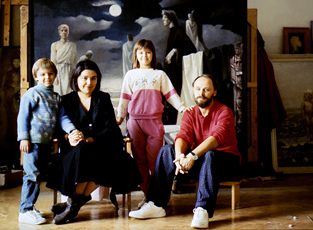


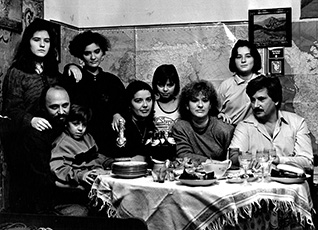
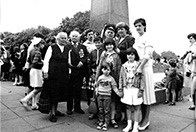
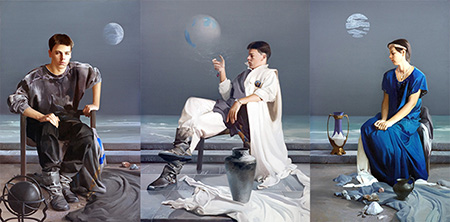

Alexander Pogrebinsky
Alla Rogers Gallery is showing oil paintings by Alexander Pogrebinsky, a Ukrainian who immigrated to Cleveland in 1991 and now teaches art at John Carroll University. He is a realist painter whose specialty is portraiture in grand European Tradition, and one cannot look at his work without marveling at Pogrebinsky’s skill with the brush. The exhibition, titled “Philosophical Realism", features portraits inspired by the thoughts of various European intellectual heavyweights, such as Johann Wolfgang von Goethe, Germany’s most famous writer.
Pogrebinsky used his wife, son and daughter as models, placing them in the foreground, in front of a vast sea that is held back by a shallow stone wall on which quotations from the great men have been carved. The walls and everything else in these beautiful works are impeccably well done, so much so that one gets lost in the painting and forgets about the philosophy.
By Ferdinand Protzman
The Washington Post
November 5, 1998
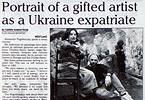
Alexander Pogrebinsky packs a mean resume.
His luminous oil paintings have been shown at national galleries and exhibitions. Chicken farms, banks, sugar factories, schools, libraries and cultural centers own his work. So do private collectors in Europe and the United States.
But those achievements belong to his other life. The one he left behind in Kiev in 1990.
“We were reborn in America, and we are only 3 years old,” he says. “I believe if I will spend a lot energy, and be stubborn, (and) I could finally find a place to teach in an institute or college . . .”
His wife, Lena, completes the thought. “We decided if we could live from his work there, we have to try here.”
The Pogrebinsky's talk about their old life and rebirth as they stand in Alexander’s delectably messy studio in Westlake. A large, unfinished scene of nearby Bradley Woods stands erect on an easel. The painting is representational but contemporary, its broad-brush strokes smudging into one another.
In a way, their tale mirrors that of other Eastern European immigrants. After years of agonizing over whether to leave the Ukraine, they were driven to their decision by governmental ineptitude.
They had long doubted the benevolence of the government, but the explosion at the Chernobyl nuclear power plant, 60 miles from their home, cemented their distrust. The disaster struck April 26, 1986. Word reached the Pogrebinsky's about five days later. Before citizens even caught wind of the accident, the militia sealed Kiev to prevent an exodus. Meanwhile, state leaders in the region fled in droves.
“We just started to see that everything we had been taught was not what hey pretended,” Says Alexander, 43. “Chernobyl just showed that they didn’t care about the people.”
In deciding to leave, the Pogrebinsky's said goodbye to family and friends, and killed a familiar way of life. Alexander was a successful artist. Lena had been an engineer and technical editor. Not everyone in Kiev owned cars, but the Pogrebinsky's did.
Aside from politics, their lives were comfortable.
The four of them – Alexander, Lena, Natasha and Alexander Jr. – used a travel visa to Paris to escape in December 1990.
They arrived in New York in January ’91, and won political asylum from the US. government.
Since arriving in Cleveland soon after that, they’ve learned English and have begun to generate their marketing machine for Alexander’s art. They credit businessman Donald Wager for giving advice and allowing Alexander to show his work at Wagner’s Country Inn, which he owns.
Alexander had one painting within the Duncan Galleries display at the NOADA Art Expo at Tower City last weekend. His work is sold through Chaika Gallery in Detroit and several Toledo venues. He exhibited at the 39th Newman Religious Show at the Hallinan Center in Cleveland in January, and he’ll have a one-man show at Mural Gallery near Playhouse Square beginning May 6.
The challenge, Alexander says, is to get to know the fickle of American art market while buyers get to know him. That means changing the focus of his work.
“I personally was more interested in (working on) philosophical ideas, and also working on historical compositions,” he says. In the former Soviet Union, he explains, people depended on art as a font of information and ideas. A prime example, a 9-by-6 foot painting of Pontius Pilate questioning Jesus titled Where Is the Truth? stands nearby as
Alexander talks. At first glance, the work looks purely religious, what with Faith, Hope and Love forming a feminine circle in the background.
On closer inspection, the firmament includes camouflaged figures. The knight in armor and a suited astronaut articulate timelessness.
But to please audiences here, Alexander fins himself panting more landscapes and still lives, as well as the occasional portrait.
The couple had not expected that making a living, as an artist would be as difficult as it has been. Had they known, Alexander says, immigrating “would be a much more difficult decision.”
But then he smiles, thinking about the promise his new homeland holds for him, his wife, and especially their children. In a way, it’s good the Pogrebinsky's didn’t foresee the difficulties ahead, he says, “Lack of knowledge helped us.”
The Cleveland Plain Dealer


Alexander Pogrebinsky
For artist Alex Pogrebinsky, there is nothing more satisfying in art than painting the face of another human being.
“To me, the most interesting surface on the Earth is the surface of the human face,” Pogrebinsky said.
One of his most recent surfaces was that of Bishop Anthony M. Pilla. A 34-by 46-inch portrait of the Cleveland bishop hangs in the cathedral rectory.
. . . Pogrebinsky started his work about a year ago. He began by scheduling two sessions with the bishop, where he interviewed him to get to know him. The artist also took several photographs of the bishop from various angles and with various facial expressions.
After the second photography session, Pogrebinsky drew a sketch of how he thought he would proceed with the portrait and showed it to the bishop to give him an idea of what it would look like. Then he started painting.
In the past, a person would have to sit still while a painter created his portrait. Using the photographs, Pogrebinsky was able to examine his different features. For example, he liked the way the bishop was holding his hands in one photograph but liked the facial expression better in another. He also added elements of interest to the painting, such as a silver candelabra, for color.
The result is a large portrait of the bishop sitting in a red chair with his hands loosely folded. He is sitting next to a table with the candelabra on it.
“It’s enjoyable to me to create something which is life itself,” said a heavily accented Pogrebinsky. “On the flat surface of the canvas, suddenly, you’ve got life.”
Pogrebinsky’s parents, both artists, encouraged their son’s artistic career when he was three. He later attended a special fine arts high school, graduated from the Kiev State Institute of Fine Arts and completed his post graduate work at the Academy of Fine Arts of the USSR in Moscow. He was schooled in the traditions of 19th century Russian art, combined with modern expressionism.
This training comes through clearly in another painting of his entitled, “Where is the Truth?” a painting of Jesus questioning Pontius Pilate. His work has been exhibited all over the world, in museums in the Ukraine, Russia, France and Germany. Locally, his work has been exhibited in Tower City and at the Barth Gallery, 2678 W. 14th St. His work is also sold in Toledo and Detroit.
“I was born into an artistic family,” he said. “It was my pleasure. It was my inclination. It was my destiny to be an artist.”
. . . “Art itself is a part of the societal life of a nation,” Pogrebinsky said. “It’s not just an amusement. It’s part of how we gain knowledge. It’s taken very seriously over there. Culture is a part of the nation. You cannot have the nation without the culture. Culture helps strengthen a society.”
Bishop Pilla said that people in the diocese have sent him paintings of himself before, but this was the first time he had participating in the formal painting of his portrait.
He admits that when he first saw the painting, he was impressed by the high quality but was a little embarrassed at seeing a portrait of himself.
. . . “I give him my gratitude and my compliments on his work,” said Bishop Pilla, who also enjoys painting. However, he prefers using watercolors to illustrate landscapes, as opposed to portraits.
He agrees with Pogrebinsky that there is something special about capturing a subject or object on the canvas as opposed to a camera.
“The photograph is just a mechanical representation of an object,” Bishop Pilla said. “The painting has something of the artist in it. An artist puts something of himself or herself into it.”
. . . “The diocese is greatly appreciative of this donation,” Father Wright said. “Everyone who has seen it has been impressed by it. It’s a great work of art.”
By Nancy M. Erikson
Catholic Universe Bulletin July 11, 1997
Erikson is a freelance writer in Willoughby Hills